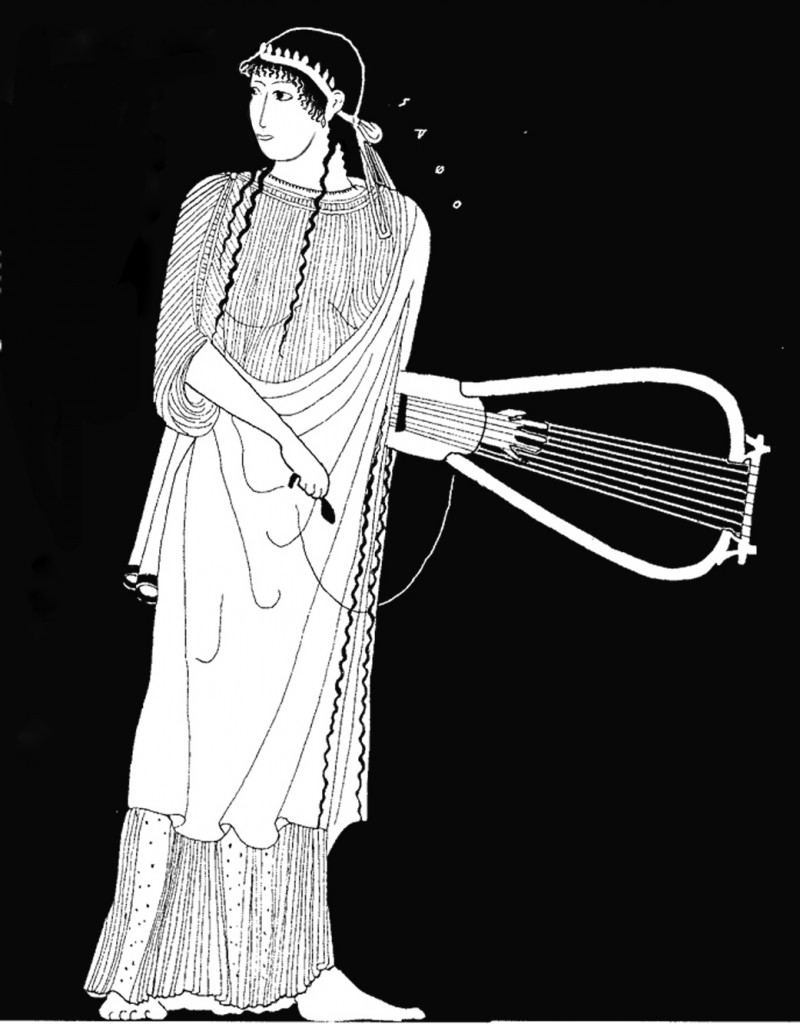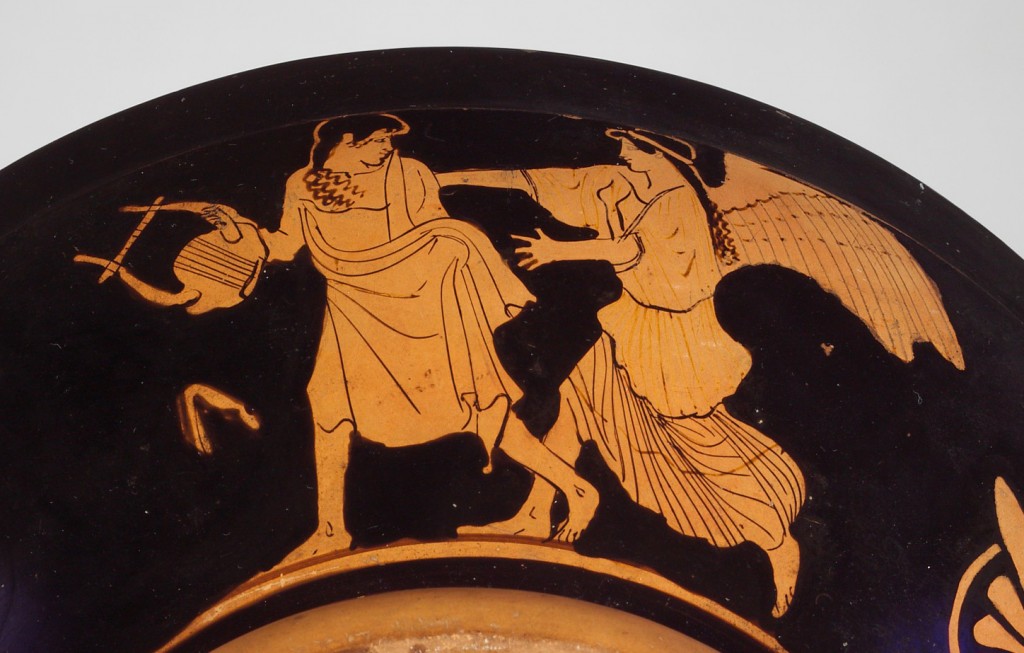Oral Traditions: Parry, Lord, and Beyond
Gathered here are selections from CHS publications pertaining to the songmaking of Sappho. The majority of them have been generated in Classical Inquiries, an online, rapid-publication project devoted to sharing some of the latest thinking on the ancient world with researchers and the general public, authored primarily by Gregory Nagy, Director of the Center for Hellenic Studies. Nagy’s approach, which combines diachronic and synchronic perspectives, encourages us to view Sappho’s songmaking as an evolving medium. In addition, published and forthcoming essays and two full-length books have been made available. This collection aims to contextualize new approaches to the poetic tradition of Sappho, while providing translations of primary material and overviews of different methodologies.
Unit 1: Introductions & Paradigm Shifts
 Gregory Nagy, “Orality and Literacy.” Gregory Nagy, “Orality and Literacy.”
From Classical Inquiries 2015.10.08: Gregory Nagy offers his own working translations of some songs attributed to Sappho, complementing his interpretations as posted in Classical Inquiries 2015.10.01. Some of these songs are part of a set of new discoveries of papyrus fragments. Nagy integrates current interpretations of the “newest Sappho” songs with earlier interpretations of songs that he began studying in the early 1970s, with special attention to his work on Songs 1, 16, 31, and 44 of Sappho. |
 Casey Dué, “Paradigm Shifts,” Homer Multitext Blog, 2011.11.10. Casey Dué, “Paradigm Shifts,” Homer Multitext Blog, 2011.11.10.
From Classical Inquiries 2015.11.05: Nagy argues that the expression dēute (δηὖτε) as used at lines 15 and 16 and 18 in Song 1 of Sappho refers not only to some episodically recurrent emotion of love as experienced by the speaker but also to the seasonally recurrent performance of the song on festive occasions that he reconstructs back to the earliest attested phases of the song’s evolution. |
 CHS Essentials Video: Gregory Nagy on Oral Poetics. CHS Essentials Video: Gregory Nagy on Oral Poetics.
From Classical Inquiries 2015.11.12: Nagy takes up from where he left off on 2015.11.5 (above), where he explored the idea of a cycle from girl to woman back to girl in the poetics of Sappho. In that essay, Nagy noted the use of the word pais in the sense of ‘girl’ in a vase painting that showed the pursuit of a girl by a woman who was in turn pursued by the girl in a seemingly eternal cycle. Nagy sees a comparable use of the word pais in the so-called Tithonos Song of Sappho, as edited by Dirk Obbink 2010. |
Unit 2: Parry and Lord
 Parry, Milman, L’Épithète Traditionnelle dans Homère : Essai sur un problème de style Homérique. Parry, Milman, L’Épithète Traditionnelle dans Homère : Essai sur un problème de style Homérique.
From Classical Inquiries 2015.10.08: Gregory Nagy offers his own working translations of some songs attributed to Sappho, complementing his interpretations as posted in Classical Inquiries 2015.10.01. Some of these songs are part of a set of new discoveries of papyrus fragments. Nagy integrates current interpretations of the “newest Sappho” songs with earlier interpretations of songs that he began studying in the early 1970s, with special attention to his work on Songs 1, 16, 31, and 44 of Sappho. |
 Parry, Milman, Les formules et la métrique d’Homère. Parry, Milman, Les formules et la métrique d’Homère.
From Classical Inquiries 2015.11.05: Nagy argues that the expression dēute (δηὖτε) as used at lines 15 and 16 and 18 in Song 1 of Sappho refers not only to some episodically recurrent emotion of love as experienced by the speaker but also to the seasonally recurrent performance of the song on festive occasions that he reconstructs back to the earliest attested phases of the song’s evolution. |
 Parry, Milman, “Studies in the Epic Technique of Oral Verse-Making: Part I. Homer and Homeric Style. Part II. The Homeric Language as the Language of an Oral Poetry.” Parry, Milman, “Studies in the Epic Technique of Oral Verse-Making: Part I. Homer and Homeric Style. Part II. The Homeric Language as the Language of an Oral Poetry.”
From Classical Inquiries 2015.11.12: Nagy takes up from where he left off on 2015.11.5 (above), where he explored the idea of a cycle from girl to woman back to girl in the poetics of Sappho. In that essay, Nagy noted the use of the word pais in the sense of ‘girl’ in a vase painting that showed the pursuit of a girl by a woman who was in turn pursued by the girl in a seemingly eternal cycle. Nagy sees a comparable use of the word pais in the so-called Tithonos Song of Sappho, as edited by Dirk Obbink 2010. |
 Albert Bates Lord, The Singer of Tales. Albert Bates Lord, The Singer of Tales.
From Classical Inquiries 2015.10.08: Gregory Nagy offers his own working translations of some songs attributed to Sappho, complementing his interpretations as posted in Classical Inquiries 2015.10.01. Some of these songs are part of a set of new discoveries of papyrus fragments. Nagy integrates current interpretations of the “newest Sappho” songs with earlier interpretations of songs that he began studying in the early 1970s, with special attention to his work on Songs 1, 16, 31, and 44 of Sappho. |
 Albert Bates Lord, The Singer Resumes the Tale. Albert Bates Lord, The Singer Resumes the Tale.
From Classical Inquiries 2015.10.08: Gregory Nagy offers his own working translations of some songs attributed to Sappho, complementing his interpretations as posted in Classical Inquiries 2015.10.01. Some of these songs are part of a set of new discoveries of papyrus fragments. Nagy integrates current interpretations of the “newest Sappho” songs with earlier interpretations of songs that he began studying in the early 1970s, with special attention to his work on Songs 1, 16, 31, and 44 of Sappho. |
 Albert Bates Lord, Epic Singers and Oral Traditions. Albert Bates Lord, Epic Singers and Oral Traditions.
From Classical Inquiries 2015.10.08: Gregory Nagy offers his own working translations of some songs attributed to Sappho, complementing his interpretations as posted in Classical Inquiries 2015.10.01. Some of these songs are part of a set of new discoveries of papyrus fragments. Nagy integrates current interpretations of the “newest Sappho” songs with earlier interpretations of songs that he began studying in the early 1970s, with special attention to his work on Songs 1, 16, 31, and 44 of Sappho. |
Unit 3: Homeric Questions & Responses
 Gregory Nagy, Homeric Questions. Gregory Nagy, Homeric Questions.
From Classical Inquiries 2015.10.08: Gregory Nagy offers his own working translations of some songs attributed to Sappho, complementing his interpretations as posted in Classical Inquiries 2015.10.01. Some of these songs are part of a set of new discoveries of papyrus fragments. Nagy integrates current interpretations of the “newest Sappho” songs with earlier interpretations of songs that he began studying in the early 1970s, with special attention to his work on Songs 1, 16, 31, and 44 of Sappho. |
 Gregory Nagy, Homeric Responses. Gregory Nagy, Homeric Responses.
From Classical Inquiries 2015.11.05: Nagy argues that the expression dēute (δηὖτε) as used at lines 15 and 16 and 18 in Song 1 of Sappho refers not only to some episodically recurrent emotion of love as experienced by the speaker but also to the seasonally recurrent performance of the song on festive occasions that he reconstructs back to the earliest attested phases of the song’s evolution. |
Explore
|
From Classical Inquiries 2015.10.08: Gregory Nagy offers his own working translations of some songs attributed to Sappho, complementing his interpretations as posted in Classical Inquiries 2015.10.01. Some of these songs are part of a set of new discoveries of papyrus fragments. Nagy integrates current interpretations of the “newest Sappho” songs with earlier interpretations of songs that he began studying in the early 1970s, with special attention to his work on Songs 1, 16, 31, and 44 of Sappho. |
 Visit the Milman Parry Collection at Harvard’s Widener Library Visit the Milman Parry Collection at Harvard’s Widener Library
From Classical Inquiries 2015.11.05: Nagy argues that the expression dēute (δηὖτε) as used at lines 15 and 16 and 18 in Song 1 of Sappho refers not only to some episodically recurrent emotion of love as experienced by the speaker but also to the seasonally recurrent performance of the song on festive occasions that he reconstructs back to the earliest attested phases of the song’s evolution. |
